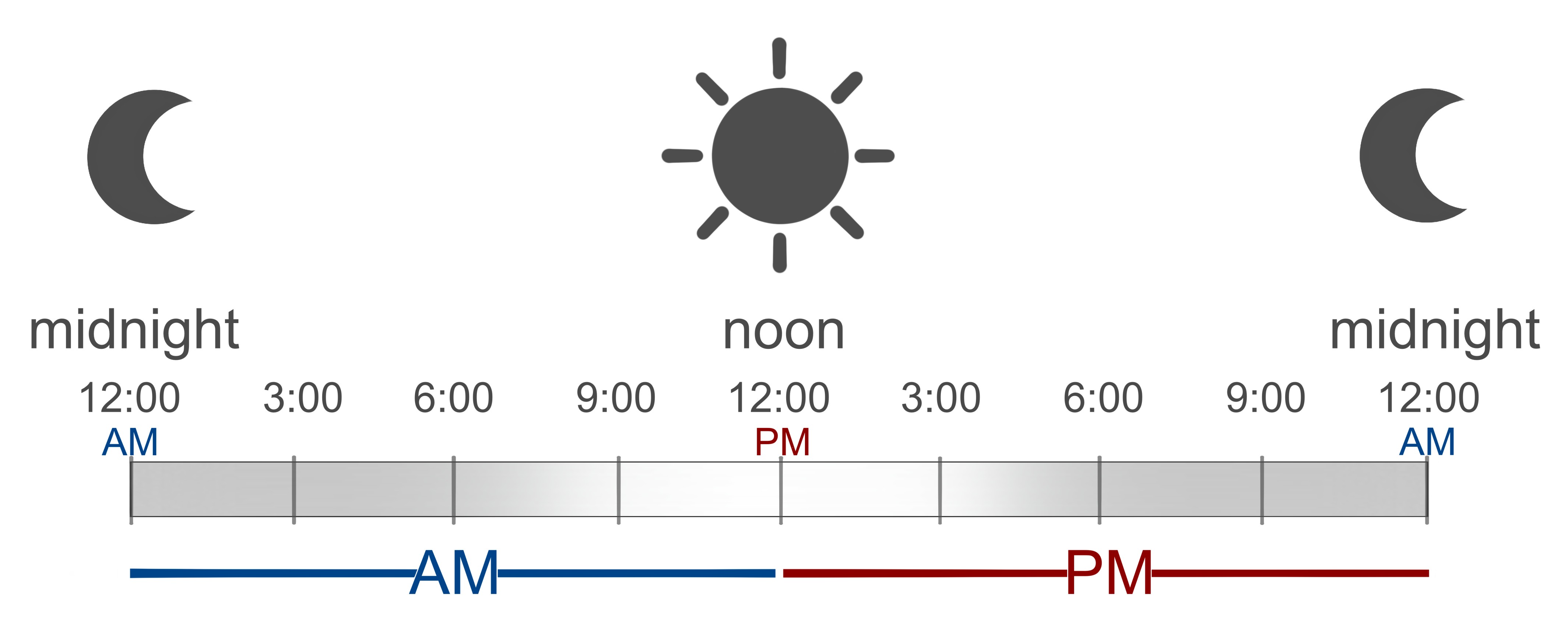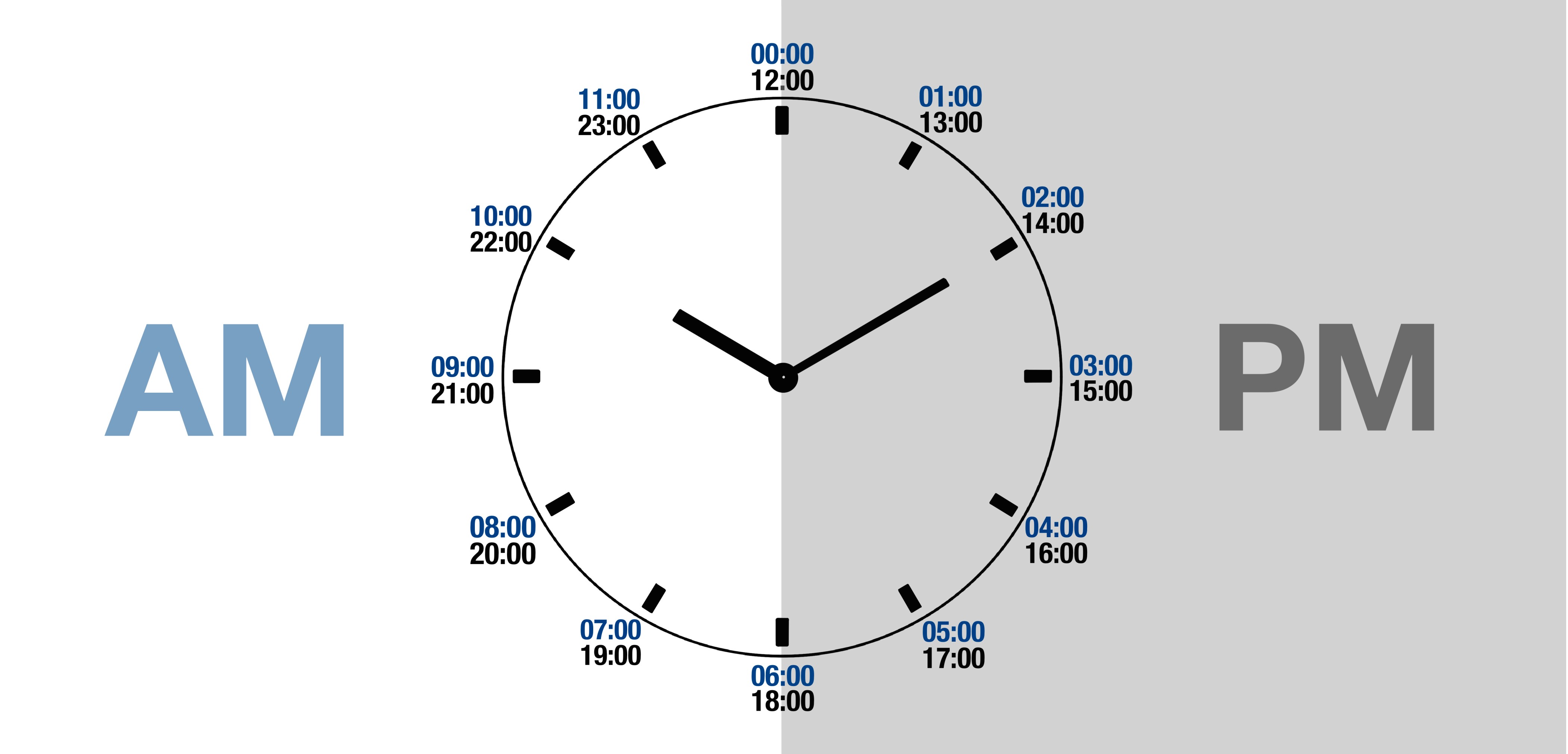What do AM and PM mean?
The meaning of AM and PM is the simple abbreviation of Latin phrases. In particular, AM stands for ante meridiem, which translates into English as ‘before midday’. Meanwhile, PM is post meridiem and means in English ‘after midday’. These abbreviations are used to identify the time in the 12-hour clock format instead of using 24 hours. Considering that day has 2 cycles, AM and PM denote whether it is before or after the middle of a day.

Issues with AM and PM
However, the 12-hour system has its flaws with the ambiguity in the understanding. It might be difficult for the people who use only a 24-hour clock to memorize when it is AM or PM. This time convention is also might be confusing for the writing because it has multiple rules regarding how to write these abbreviations.
Even though the 12-hour clock is peculiar to many countries and cultures, other nations still face issues with the proper comprehension of AM and PM. Subsequently, AM and PM remain to be a common and yet ambiguous tradition of how people refer to time.
Why AM and PM?
The tradition to measure time with a 12-hour standard has been effective since ancient times. In particular, people were able to measure time only using the sun. Therefore, with the help of sundial clocks, ancient people were able to identify time only during a particular period of the day. Eventually, the decision to divide a day into two cycles which lasts 12 hours was influenced by the fact that the moon also had 12 cycles.
When AM and PM?
One of the most common ambiguities of AM and PM was the confusion regarding the start of a day. Namely, it is difficult to determine the starting point of the day cycle. To avoid the confusion regarding denomination of noon and midnight, the convention refers to 12 AM as midnight and to 12 PM as noon. Although technically, midnight implies AM, the lack of clarifications regarding whether it is 11:59 PM or 12:01 AM might be misleading and ambiguous. Hence, it is highly ineffective to use only ‘midnight’ when indicating a date of event.
Where AM and PM?
Despite the ambiguity of the 12-hour time convention, it is used in many countries. Namely, this tradition is peculiar to the English speaking states and territories which were part of the British Empire. The following countries utilize the 12-hour clock to denominate time:
- The United Kingdom
- The United States
- Mexico
- Canada
- Egypt
- Bangladesh
- Australia
- New Zealand
- Malta
- Malaysia
- The Philippines
The most common argument in favor of using the 12-hour convention is easy pronunciation. It is easier to say 6 PM rather than 18 hours. Hence, the use of AM and PM is more of a convenience decision.
How to write AM and PM?
Another confusing notion about the use of AM and PM is to understand how to properly write it. Different style guides suggest different types of writing the abbreviation. For instance, there could uppercase AM/PM or lowercase am/pm. Also, the use of the period between the letters (A.M./P.M.) might be acceptable. Nevertheless, the most common rule in formal writing is to use uppercase AM/PM1. The lack of consistent rules among all style guides is the primary factor why people could face the issue of how to write the time appropriately.
How to memorize AM and PM?
For the people who just encountered the 12-hour convention, it might be difficult to memorize to what part of the day AM and PM refer to. However, there is a simple solution that does not even require to know the actual translation of the abbreviations (ante/post meridiem).
AM — starts with the first letter of the alphabetA. Considering that AM corresponds to the start of the day, knowing that A signifies the start of the alphabet could be a perfect point of reference for memorizing.
Meanwhile, the fact that AM is alphabetically closer that PM should be the designation that it is before the midday.
12 vs 24 hours

With the ambiguity of 12-hour clock convention, many establishments require that this time representation should be scrapped altogether. It could be used in conversations and informal communication only. However, the legal documents, schedules, and other interactions that require high precision time identification should follow the 24-hour format to avoid confusion with the denomination of noon and midnight. For instance, the confusion whether 12 o’clock is 12:00 or 00:00 is the most common issue for the AM/PM format.
One standard for all
Considering that 24-hour clock is the most effective system of timekeeping and it is used for high precision coordination, the international organizations managed to provide the most effective solution. The International Organization for Standardization (ISO) proposed to implement one format for the information exchange. Therefore, the standard ISO 8601 implies that all countries should use the specific format to indicate date and time (24-hour clock) and it should be used for documentation and formal communication2. However, the international agreements do not directly regulate how organizations within the countries use timekeeping format for the interactions and communication. Hence, some domestic organizations could proceed to use AM and PM.
Conversion
People who got used to 12-hour clock and AM/PM also complain that 24-hour format is baffling and require to apply the conversion and the particular thought process when referring to time. The most strange scenario remains to be the moment when one watches on the 12-hour clocks or wristwatches and should convert the time into the 24-hour format. Nevertheless, the rule for the AM/PM to 24-hour format conversion is simple. Namely, if it is 3 PM, one needs to add 3 to 12. The sum will be 15. The same goes for adding another corresponding number to 12.
Military time
The coordination of military actions requires the precise and unambiguous comprehension of time. Since the solar day is the primary measure of time, the military establishments utilize 24-hour clock format and do not separate hours minutes. For instance, instead of Noon or 12 PM (civilian time), military time denotes 1200 which should be pronounced as twelve hundred. The same pronunciation is also used to indicate time in radio communication. This format is the most exact way to refer to time and use it for navigation and scheduling.
Final thoughts on AM and PM
Even though the 12-hour time format might be puzzling and ambiguous for many people, it is still the most popular format for the wristwatches. Moreover, referring to time in a less complex manner is convenient for informal communication on matters which do not require precise timing.
However, AM/PM within the 12-hour time format is not effective way to indicate the precise time. There might be confusion regarding the time of a day as well as it can mislead in the date when midnight is not properly indicated. Considering that legal and other formal standards require the use of 24-hour convention, the utilization of AM and PM would remain only as the tradition in informal communication.
References and article sources
- Paul Brians. Common Errors in English Usage: Third Edition. 2013. William, James & Company. ISBN-10: 1590282639.
- ISO 8601-1:2019 Date and time — Representations for information interchange iso.org